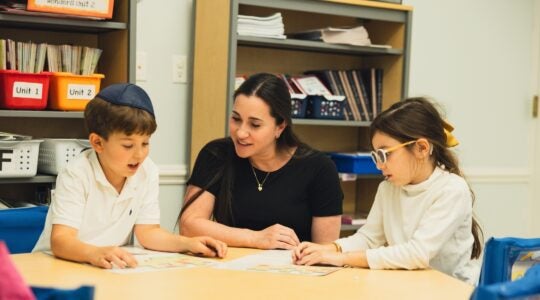Many around the country held their breath recently as President Barack Obama read the names of the 20 children who were killed in the Newtown, Conn., school massacre on Dec. 14.
Even more eloquent than reciting ages or deeds or addresses, is the simple sound of names, as one newspaper wrote, “the haunting roll call of a class that will never meet again.” Gasps of sorrow could be heard in the crowd at the interfaith service at Newtown High School as the president slowly intoned the names of the young victims.
In the Jewish community, we recite the names of the departed at the graveside, at Yizkor and on yahrtzeits. Many communities read the names of Holocaust victims on Yom HaShoah. It is almost as if, in the mere mention of a name, we can somehow, for a moment, bring the dead back to life.
A more recent example of reciting the names of the dead has taken hold in numerous synagogues around the country in recent years. It is the public reading of the names of the fallen and captured American servicemen and women, both Jewish and non-Jewish. Here is a recent example:
These are the names of our sailor and soldier killed in action one recent week, respectively, supporting Operation Enduring Freedom, plus the name of our captured soldier:
Navy Petty Officer 1st Class Nicolas D. Checque, 28, of Monroeville, Pennsylvania
Army Staff Sergeant Wesley R. Williams, 25, of New Carlisle, Ohio
Captured June 30, 2009 in Afghanistan: Army Sergeant Bowe R. Bergdhal, 27, of Ketchum, Idaho
I’ve been hearing the names of the fallen in Afghanistan in my synagogue, Congregation Ramath Orah, an Orthodox shul on the Upper West Side, for about a year. Our rabbi, Moshe Grussgott, is a chaplain in the U.S. Army reserves, so I figured that he initiated the practice. He always ends the recitation with the words: “May God comfort their families.” But I soon found that some other congregations — Orthodox, Conservative, Reform and Reconstructionist — were also reading the names.
Where did this practice begin? And who initiated it? I can remember back to the Korean War, the war of my childhood. Names of the fallen in that war or in Vietnam or in the first Gulf War were not recited in synagogue. Why this war and why now?
I called the major national congregational and rabbinic bodies and learned that this is not a top-down practice. Rather, it seems that this is something that has bubbled up from the grass roots — the synagogue and temple members themselves. And the practice is made possible, in large measure, thanks to the Internet and the sense that our involvement abroad is, above all, a war on terrorism.
Rabbi Grussgott told me that he gets a weekly casualty list by e-mail from a Ramath Orah member, Rabbi Saul Berman, who in turn gets the list from Mark I. Wald, a member of Lincoln Square Synagogue, where Rabbi Berman once served.
Wald, a 77-year-old veteran who was on active duty in the army in the late 1950s, told me that he goes to a Defense Department website each week, www.defense.gov/releases, and compiles a list of the fallen. He then sends it to seven contacts, who then in turn pass it on to others.
Wald said that he began the practice about eight years ago during the Iraq War. He noticed that his shul would routinely read the names of fallen Israeli soldiers but not those of the Americans dead. “I just felt, we’re Americans and we ought to be recognizing the sacrifices of our military personnel,” he said.
“There are people who seem to forget that regardless of their love and attachment to the state of Israel, we live in the United States,” Wald added. He said that he approached the Lincoln Square rabbi at the time, Rabbi Adam Mintz, who embraced the idea. It has been done ever since.
Another synagogue that has been reading the names for many years is the Jewish Community Center of Paramus, N.J., which is affiliated with the United Synagogue of Conservative Judaism. “Every Friday night we read the names of those killed in action during the previous week, right after the weekly yahrtzeit list,” said the rabbi, Arthur Weiner. “We have been doing this since about a year after the war in Iraq began.”
Rabbi Weiner emphasized that the shul was “not making a political statement for or against any position” by reading the names. Rather, he said, it is done “to remind us each week of the real human cost of these wars, something that successive administrations have (in my opinion) never fully addressed.”
He and others said that the practice has been “well received” by members and guests alike.
Among those who receive Wald’s weekly e-mail is Shaul Hen, the director of operations at the Orthodox Rabbinical Council of America. Hen puts the list on the RCA website to make it available to congregations who want to use it.
The Union for Reform Judaism goes a step further. “Each week,” said Rabbi Richard Jacobs, the president of the URJ, “the names of the casualties are distributed on our listserv for Reform rabbis.” Some rabbis use them in the synagogue bulletin, and others recite the names during the Shabbat service.
Rabbi Grussgott said that reading the names has another benefit in “forcing us to consider how high the casualty rate is in this war.”
“Every week there are new names,” he said. “It is unrelenting. I keep hoping for a week when there are no more names to be read.”
The New York Jewish Week brings you the stories behind the headlines, keeping you connected to Jewish life in New York. Help sustain the reporting you trust by donating today.




